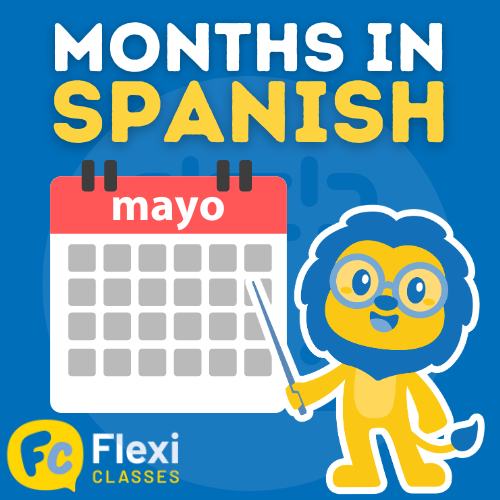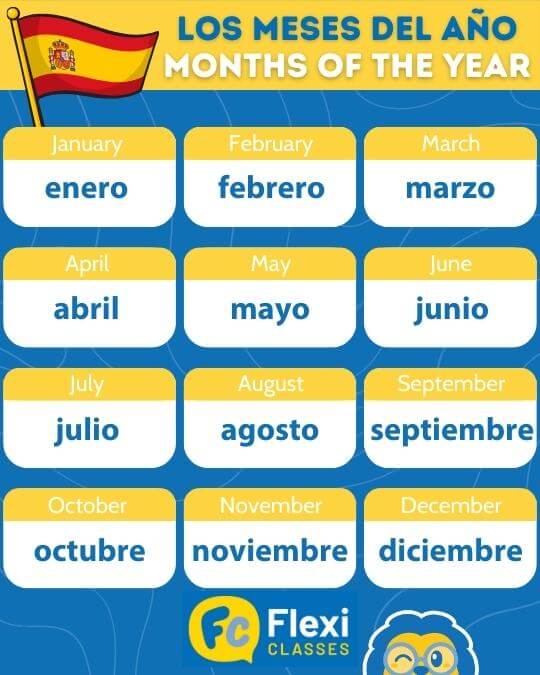Months in Spanish 📆 || Key Vocabulary and Cultural Insights
Learn How to Say the Months in Spanish and Find Out How Spaniards Spend the Year

No matter if you’re talking about birthdays, business trips or holiday plans, months are essential vocabulary you need to know in Spanish.
So in today’s blog, we’re going to teach you how to say each month in Spanish.
We’ll also have a peek at what you can expect to typically occur in Spain within a given year and include some useful phrases for each season.
There is never a dull moment!
BONUS 🔊We’ve even added audio for you so you can practice saying each month in Spanish!
Months in Spanish || How to Say Each Month
Months in Spanish || January: Three Kings and the January Bump
Months in Spanish || March: la primavera, la sangre altera
Months in Spanish || Summer and Vacations: ¡llegó el verano y las vacaciones!
Months in Spanish || End of summer vacations and start of school and work
Months in Spanish || National Day: Día de la Hispanidad, ¡fiesta nacional!
Months in Spanish || December: Fiestas de navidad y ¡felices fiestas!
Months in Spanish || FAQs
Months in Spanish || How to Say Each Month
| January | enero | July | julio |
| February | febrero | August | agosto |
| March | marzo | September | septiembre |
| April | abril | October | octubre |
| May | mayo | November | noviembre |
| June | junio | December | diciembre |
Some more points to remember: months in written form are not capitalized.
Also, know that all months are in the masculine form (for example, ha sido un mayo lluvioso – ‘it has been a rainy May’ or febrero pasa muy rápido – ‘February lapses very quickly’).

Months in Spanish || January: Three Kings and the January Bump
A big date to remember in January (enero) that is celebrated all over Spain is the festivity of the Epiphany. It’s colloquially referred to the Three Kings (often abbreviated to el día de Reyes) and is celebrated on January 6th.
It commemorates the Christian tradition of the visit of the three Magi – Melchor, Gaspar and Baltasar – to the infant Jesus, bringing gifts of gold (oro), frankincense (incienso) and myrrh (mirra).
No Santa Claus, yes Three Kings. Spanish children believe in the Three Magi, who on the evening of the 5th arrive laden with gifts.
To symbolize this arrival, practically most cities and towns throughout Spain organize big parades on that evening, showcasing floats (carrozas) carrying the three kings that have disembarked from the Far East accompanied by their courtiers.
Most families either watch the televised parade or flock to the streets where really excited children anxiously wait to catch a glimpse of the three kings, as they know that when they wake the next morning, the three kings will have delivered their gifts to their homes.

8 Ways to Say Hi in Spanish – Say Hello Like a Local
Different Ways of Saying Hi in Spanish, Fit for Each Occasion! There are many ways to say hello in Spanish, based on several factors… Is it a formal or an informal occasion? Are you close friends or have you just…
Months in Spanish || March: la primavera, la sangre altera

Spring in Spain typically begins between March 20-21. The weather is mild and days start to get longer (nightfall occurs later).
🌸 It is a beautiful season where the winter ice melts, flowers bloom, nature is regenerated and, overall, is a great respite from the winter.
The well-known Spanish idiom la primavera, la sangre altera (loosely translated to ‘spring is in the air ‘or literally to ‘spring alters the blood’), depicts all these changes that sprout out with each incoming spring.
Suddenly, outdoor bar and restaurant terraces are bustling with people anxious for sun and warm weather.

Food in Spanish || Essential Vocabulary & Must-Eat Dishes
Spanish Food Vocabulary || And The Million Dollar Question: What Time Do People Eat in Spain? Spain is Different- once a national slogan. True to that phrase, you’re going to need some adjustments when it comes to mealtimes in Spain….
Months in Spanish || Summer and Vacations: ¡llegó el verano y las vacaciones!

The school year ends in June (or so the government calendar dictates), it’s summer time!
The official date within the month varies from year to year but the start of summer vacations for schools and universities, etc. has always been in June.
Now, for the rest of the (working) population, typically the month of August, is when most public institutions and businesses shut down for a mandatory 30 day vacation period.
It’s time to put away those text books, go to summer camp, hit the beach, pick up a new skill, brush-up on a new language… anyway you look at it, it’s time enjoy that long summer break!
During the month of August, there is usually an exodus of the local population from the bigger cities and towns to the coastal areas of Spain, mountain ranges or other typical vacation spots (mountains, sea or other local or foreign tourist destinations).
So don’t expect to get much done or to do much business during the ghost month of August, as mostly things are postponed up until the end of vacations, the month of September.
Months in Spanish || End of summer vacations and start of school and work
El fin de las vacaciones, vuelta al cole y al trabajo. End of vacations, back to school and work!
¡Comienza el otoño! Autumn commences!
You will hear these phrases fairly often in September.
Come September, businesses that had shut down for the summer and schools in general, reopen their doors.
Initial meet and greet conversations are mostly on how your summer vacations went… and then the fall happens!
Typically, autumn (otoño) in Spain commences between 22-23 of September and for the most part, expect rain and wind, as heralds the local saying:
si en septiembre ves llover, el otoño seguro es. – If you see rains in September, then autumn it is for sure.
Months in Spanish || National Day: Día de la Hispanidad, ¡fiesta nacional!
A day of significance, not only in Spain but also in other Spanish-speaking countries around the world is the Spanish National Day, Día de la Hispanidad, celebrated on October 12th.
It is a national holiday meant to commemorate the Spanish legacy – historical, cultural, linguistic, etc. – worldwide.
It is also the Day of the Armed Forces (Día de las Fuerzas Armadas), so expect grandiose military parades, many proud citizens waving Spanish flags and plenty of acts of commemoration that are quite well attended, including by dignitaries such as the King and the prime minister.
Months in Spanish || December: Fiestas de navidad y ¡felices fiestas!
As we hit the end of the year, expect a festive and frenzied month of December!

You’ll encounter major commercial streets donned with a display of pretty Christmas lights, Yultide markets popping up, and chestnut vendors, and maybe you’ll attend a Christmas party or two.
There are two national holidays lined up during the month of December, the Day of the Constitution (December 6) and, of course, Christmas (December 25).
A tip: if you want to greet someone a Merry Christmas or Happy Holidays, a ¡feliz navidad! or a ¡felices fiestas! will do the job.
Months in Spanish || FAQs
What are the four seasons in Spanish and when do each of them commence?
Before we dive in, know that all seasons are in the masculine form, except for Spring, she’s feminine. Note that the seasons in Spanish are not capitalized.
winter – invierno (masculine, el invierno). Winter typically starts between December 21-22.
spring – primavera (feminine, la primavera). Spring typically starts between March 20-21.
summer – verano (masculine, el verano). Summer typically starts between June 20-21.
autumn/fall – otoño (masculine, el otoño). Autumn typically starts between September 22-23].
How do you write the date in Spanish?
So, for starters, we use cardinal numbers (one, two, three, etc.) for the days of the month and always follow this sequence:
Date + Month + Year. For example, in reference to January 4th 2024: cuatro de enero de 2024.
In Spanish, what is the correct format for a monthly numerical sequence?
Different to the American format, in Spanish, when writing a specific date in a numerical sequence, the day goes before the month.
So if an expiry date on a Spanish passport were to be the 7th of June 2030, it would look like this: 07/06/2030, whereas in the US, it would be stated in the reverse 06/07/2030.
Are there any instances wherein the spelling of a month is capitalized in Spanish?
Yes, when the month is used as a proper noun, meaning, when referring to a place/location, street name, holiday, etc. and, of course, if at the beginning of a sentence.
For instance: Hospital Universitario 12 Octubre
Plaza del 2 de Mayo
Calle del 12 de Octubre
Are there any acceptable/common abbreviations in Spanish for each month?
Yes, these are the commonly accepted abbreviations for the months in Spanish (and no need to capitalize either):
en., feb., mar., abr., may., jun., jul., ag./agto., sept./set., oct., nov., dic.
Want More From LTL?
FANCY LEARNING SPANISH? Check out our online Spanish courses here.
We offer a 7-day free trial to all online students where you can study Spanish 24/7. It doesn’t end there either.
We teach over 10 of the world’s most popular languages 😎
Come and be a part of our amazing community.









